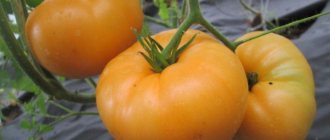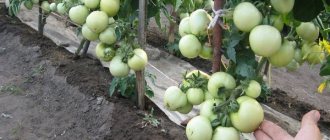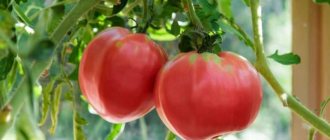Description of tomato variety Sugar Giant
Sugar giant is an indeterminate (tall) plant, which is characterized by the development of a bush without stopping the growth of the central stem. The main shoots of the plant are thin, but quite strong. The height of each reaches 2 m in open ground and about 1.5 m in greenhouse conditions. The stem of tomatoes is hung with a large number of fruits, so it requires an obligatory garter, and sometimes even separate support from especially large brushes.
Tomatoes of this variety have gained popularity due to their good taste and high yield.
There are few stepchildren. The leaves of Sugar Giant tomatoes are dark green, large, drooping. The foliage level is moderate, which creates good conditions for lighting and ventilation of the bushes.
The first cluster of tomato flowers appears above the ninth leaf, and all subsequent ones appear every 2 internodes. An average of 6 fruits are produced from one cluster of the Sugar variety (in order to obtain large tomatoes, some of them are removed).
The full harvest of Sugar Giant tomatoes grown in unprotected soil is obtained in warm regions, while in cool regions some of them simply do not have time to ripen. In greenhouse conditions, this variety can be grown in almost all regions of the country.
Important! Tomatoes have the ability to ripen after they are picked from the bush. However, due to the short shelf life, only a small part of the fruits that have not reached full maturity are left for ripening.
Description of fruits
The Sugar variety of tomatoes is characterized by the presence of large (about 300 g) heart-shaped fruits. Unripe tomatoes are light green in color with a dark spot near the stalk. As tomatoes ripen, they turn red-pink. The pulp is juicy, without a hard core, and contains few seeds. The peel of tomatoes is quite thin, which does not allow transporting the harvested crop over long distances. In addition, thin skins sometimes cause ripe tomatoes to crack. However, such troubles only happen when the soil is waterlogged during cultivation in open ground. Tomatoes cultivated in greenhouses, as a rule, do not crack.
The weight of one Sugar grade tomato is about 300 g
The taste of tomatoes is assessed as high. A decrease in aroma or sugar content can only occur during the rainy season. Bad weather does not affect fruit size and yield.
Attention! This tomato variety is characterized by a higher sugar content and the powerful natural antioxidant lycopene compared to other varieties, which makes this vegetable especially beneficial for health.
General characteristics, differences from other subspecies
Tomatoes in this category fit perfectly into the concept of growing in greenhouses, but the variety is also successfully suitable for planting in open ground. Amazing fruits reach a length of 13-16 cm, and their weight is often more than a kilogram.
The characteristics described below will be understandable for experienced summer residents who want to diversify their routine garden beds with new vegetables and rich red elements of ripe fruits. Tomatoes of this variety:
- determinant (visual criterion);
- large-fruited (the size of a ripe tomato);
- mid-season (fruiting time);
- productive (number of ripe tomatoes per bush).
The graceful stem of neat bushes, overgrown with emerald-colored leaves, grows on average up to a meter. The initial brush begins the process of forming 7-9 greenish leaves above the surface, others appear after 1-2.
The amazing yield amazes novice gardeners, becoming the main topic of dacha discussions between neighbors in their plots. With proper care, just one bush produces 5-7 kilograms of sugary fruits of delicious tomatoes.
Characteristics of the sugar giant tomato
Sugar giant tomatoes are not currently registered in the State Register. For this reason, the characteristics of the variety were compiled primarily on the basis of reviews from amateur vegetable growers.
Sugar giant tomato yield and fruiting
Sugar giant is a medium-late variety of tomatoes, the fruiting period of which begins approximately 120 days after germination. In warm regions, the first ripened fruits are available after about 110 days. The fruiting period of Sugar Giant tomatoes depends on weather conditions. So, for example, when grown in greenhouse conditions, it can last about 2 months, and in open ground conditions it ends with the onset of frost.
The yield of Sugar Giant tomatoes is 4-8 kg per bush
Throughout the entire season, one long shoot produces 9-12 bunches of tomatoes. The next ovary in the upper part of the shoot is formed after the lower fruits ripen and are picked.
From one bush you get at least 4 kg of tomatoes. Proper care can increase this figure to 6-8 kg. Thus, with a density of 3 bushes per 1 sq. m there is a chance to get a harvest of about 18 kg of Sugar variety tomatoes.
Area of application of fruits
Its excellent taste makes Sugar Giant an indispensable ingredient in seasonal vegetable dishes. And the juicy pulp and rich red color allow tomatoes to be used in the preparation of sauces and juice. The fruits are not suitable for whole-fruit preservation because they are too large.
Tomatoes are used to produce juices and sauces
Resistance to diseases and pests
The resistance of tomatoes of this variety to diseases and pests depends on its growing conditions:
- the plant may be susceptible to late blight, because the period of tomato ripening occurs at the peak of late blight activity;
- excessive soil moisture can cause fungal diseases;
- another enemy of the plant is blossom end rot, which is caused by a deficiency of calcium in the soil;
- They love tomato bushes and insects, in particular the Colorado potato beetle and the whitefly butterfly.
Feed tomatoes every 2 weeks
| Stage 1. Planting seedlingsStep 1. Carry out the work in early May. Add fertilizer to the soil and dig it up. Step 2. Plant the tomatoes according to a 60x70 cm pattern. Water the plants generously | |
| Stage 2. WateringStep 1. A day before work, pour water into containers so that it settles and warms up. Step 2: Water your tomatoes once a week after sunset. Watering rate per bush – 6-7 l | |
| Stage 3. Loosening Step 1. Loosen the soil after each watering. Step 2. Weed twice a month | |
| Stage 4. Feeding Step 1. Purchase complex mineral fertilizer and composition for foliar feeding. Step 2. Apply bait once every 2 weeks. Alternate complex fertilizer and spraying of tomatoes for the best effect | |
| Stage 5. Tying Option 1. A crossbar is secured above the plants. Plants are tied to it with twine or strips of fabric, as in the example in the photo. Option 2. A peg is driven in near each bush, to which the stem and flower brushes are tied. | |
| Stage 6. Harvest Step 1. Remove tomatoes as they ripen to relieve stress on the plant. Step 2. Remove all damaged and rotten fruits from the area |
Advantages and disadvantages of the variety
Sugar tomatoes are characterized as a high-yielding variety of tomatoes, characterized by good taste and long fruiting period. Recommended for fresh consumption, making juices and sauces.
Tomatoes of this variety are characterized as high-yielding
pros
- the presence of sweet pulp and pleasant aroma;
- long period of fruiting of tomatoes;
- the presence of drooping foliage, providing lighting and ventilation of the bushes;
- high productivity;
- the ability to independently collect seeds;
- adaptability of tomato to bad weather conditions;
- the unpretentiousness of the plant, making it easier to care for.
Minuses
- the presence of too thin stems, which makes it necessary to monitor their fastening and support of the brushes throughout the entire growing season;
- poor keeping quality of tomatoes, which shortens their shelf life.
Varieties for the Central region
In the Moscow region and nearby areas, indeterminate varieties are grown both in street soil and in greenhouses. When planting outside, seedlings are planted no earlier than the beginning of May, when the weather is warm and at night the temperature does not drop below +8 degrees. When grown in greenhouses, the deadline comes a couple of weeks earlier, from about mid-April. At the initial stage of cultivation, in the event of cold weather, the seedlings must be covered outside, otherwise the plants will freeze and may die. With proper care, outdoor tomatoes ripen a little later than greenhouse tomatoes, but their taste is not inferior to them.
Puzata Khata
Mid-early indeterminate varieties include the Puzata Khata tomato. In the Central region it is grown in greenhouses and outdoors. When grown in greenhouses, the yield is 9-10 kg per 1 sq. m, and for street use - 6-7 kg per 1 sq.m. The bushes are tall, under 2 m, the leaves are of medium size. It is recommended to form a plant with 2 stems. Fruiting occurs 80-90 days after planting. The tomatoes are large, weighing 250-300 g. The pulp is very juicy and sweet. Tomatoes have a universal purpose: they are suitable for salads, cooking, and for preparations. Puzata Khata is not susceptible to late blight and other diseases because it has excellent immune capacity. Tomatoes have many positive qualities:
- excellent sweet taste;
- large fleshy fruits;
- disease resistance;
- early ripening period;
- possibility of landing outside.
One of the negative aspects gardeners mention is sensitivity to the soil: it must be balanced and fertile. The use of fertilizers based on microelements for the variety is a mandatory stage in cultivation, otherwise the taste characteristics of the fruit are reduced.
Attention! Tomatoes respond well to fertilizing with potassium sulfate, other potassium salts and superphosphate.
Monomakh's hat
The bushes grow quickly and reach 170 cm in height. The bush is indeterminate, pinching is necessary, most often it grows in 1-2 stems. Doesn’t like too dense plantings, so more than 3 plants per square meter. m are not available. The yield is high - with greenhouse planting, it is possible to harvest up to 20 kg of fruit per sq.m. per season. Outdoor cultivation is possible, but then the yield will drop to 12-14 kg per sq.m.
The fruits ripen 110-120 days after the seeds germinate. The taste of the pulp is sweetish, with a slight sourness. The skin is pink in color and feels durable to the touch. The weight of one fruit ranges from 500 to 800 g. Monomakh's Cap is grown for fresh consumption and for processing. Tomatoes make delicious juices, tomato paste and purees. Resistance to late blight and other diseases is high. The advantages of the variety include:
- good taste characteristics;
- gigantic size of fruits;
- high stable yield;
- resistance to temperature changes;
- strong immunity.
The disadvantage of Monomakh's Cap is the short shelf life of the fruit. Tomatoes are not suitable for long-term storage as they spoil quickly.
Raspberry miracle
The Raspberry Miracle has long been a favorite hybrid variety of domestic gardeners. Indeterminate bushes reach a height of 2 m, they are quite powerful and spreading. The plants are grown in a greenhouse, but are sometimes planted outside as they are suitable for open ground. The yield indicator is at least 10 kg of selected tomatoes per planting meter of land. Tomatoes are pink in color, weighing 300-400 g. The shape is beautiful and regular. The pulp is protected by a strong skin, so the tomatoes do not crack and can be stored for a long time. The main purpose of cultivation is fresh consumption and processing. Of the positive qualities of the Raspberry Miracle, they note:
- attractive appearance;
- ability for long-term storage;
- good keeping quality;
- universal purpose;
- high resistance to late blight and other diseases.
The disadvantages of Miracle include late germination of fruits, since the first harvest ripens 130-150 days after planting. Early planting of seeds for seedlings is required, approximately from the beginning of February.
It will be useful for you: Early-ripening tomatoes are resistant to diseases and frosts. The correct choice of variety makes it easier to grow tomatoes and guarantees a good harvest. It is profitable to grow in a greenhouse...
Features of cultivation
Tomato seedlings, both in open ground and in a greenhouse, are planted approximately 60-70 days after the seeds enter the soil. It is this indicator that should be taken into account when determining the sowing time.
If seedlings of low-growing tomatoes can be grown in one large container, then for picking a tall Sugar Giant you will have to prepare separate glasses.
There are no special requirements for the composition of the soil mixture for tomatoes. The main condition is that it should be light and fertile. Therefore, ready-made soil for nightshades is quite suitable for sowing seeds. You can prepare the soil yourself by combining peat, sand and garden soil in equal parts. Just before use, it is advisable to disinfect it, for example, heat it in the oven. This will destroy small pests and protect seedlings from diseases.
For sowing seeds:
- fill the container with soil;
- plant the seeds, deepening them by about 1.5 cm, the distance between them should be 2 cm;
- using a spray bottle, moisten the soil evenly;
- cover the container with glass or plastic film, this will help create a greenhouse effect;
- After germination, the film or glass is removed.
Warning! Each subsequent watering should be carried out when the soil in the container dries 1.5 cm.
Seedlings are picked after the formation of two true leaves. To do this, carefully remove it from the soil, cut off the root (by about one third) and transplant each plant into a separate glass (you can take large plastic ones). This procedure is necessary for better development of the root system.
Tomato seedlings are planted in open ground after the soil has warmed to 10 °C. A prerequisite is the absence of night frosts. As a rule, this is the second half of May. Seedlings can be planted in the greenhouse in the second half of April
The stems of the crop are very thin, so they need to be tied up
About 2 weeks before planting in the garden, young seedlings are taken out into the air. This is done only during daylight hours, gradually increasing the hardening time.
To plant seedlings:
- make holes slightly larger than the glass in which the plant is located, put humus or peat on the bottom;
- carefully remove the glass, place the plant along with the soil mixture in the hole, deepening it to the base of the first leaves, cover with the remaining soil and lightly press down with your hands;
- water the seedlings.
Attention! The distance between bushes should be at least 60 cm.
In most cases, the Sugar Giant is planted in two lines with an interval of 50 cm. And the distance between the rows is approximately 80 cm. Thus, no more than 3 bushes can be placed on each square meter.
Picking of seedlings is carried out after the appearance of the second leaf
Plant care includes:
- regular watering (the plant is afraid of excessive moisture, so it needs to be watered 2-3 times a week);
- weed removal;
- loosening the soil; if the soil is mulched, there is no need to loosen it;
- tying the plant stems to trellises or supports of a similar type, if necessary, install additional supports for heavy brushes;
- removing stepsons and lateral shoots (ideally, leave two stems from each bush);
- Fertilizing tomatoes, which is done twice a month, first uses cow manure as a fertilizer, and after the end of the flowering period, superphosphates are used.
The nuances of growing in open ground and greenhouses
To extend the growing season of a late-ripening variety in open ground, you can plant seedlings in the soil two weeks earlier, but using temporary shelters from the night cold. They are portable frames and covering material such as spunbond. A month before the onset of autumn cold, it is necessary to remove new flower ovaries - this will allow the remaining ones to reach a mature state.
The same is done with greenhouse plants, but at a later date.
Pest and disease control
In the process of growing tomatoes, you may encounter problems such as:
- Blackleg, a fungal disease characterized by blackening and subsequent rotting of the root collar and lower part of the stem.
It is impossible to cure the plant, so it will have to be removed along with a lump of earth. This will help protect nearby specimens from infection. To prevent blackleg, add ash or copper sulfate to the soil. Blackleg cannot be cured
- Late blight, a fungal disease, the main signs of which are dark spots on the fruits and leaves of the plant.
To prevent and treat the disease, special drugs are used - Hom, Fitosporin, Ordan, Bordeaux mixture. The appearance of dark spots is considered a sign of late blight.
- Nematode, the disease is a lesion of the root system with the formation of spherical growths.
The plant withers and then dies. It is impossible to cure the nematode, so diseased bushes will have to be removed. Nematode is irreversible damage to the root system
Insects can also harm the crop:
- Colorado beetle.
Before the ovary appears, the pest can be controlled using insecticidal preparations. And during fruiting, the Colorado potato beetle will have to be collected manually. When the ovary appears, the Colorado potato beetle will have to be collected manually - Whitefly.
To prevent and destroy this pest, seedlings are sprayed with Fitoverm solution twice during the growing season in a ratio of 10 ml of the drug per 1 liter of water. Intavir is also suitable for this purpose, one tablet (or packet) of which is diluted in 10 liters of water. To kill whiteflies, the plant is treated with insecticides.
How to grow tomatoes
Seedlings are planted in open ground or a greenhouse at the age of 60 days.
Landing
An additional condition for planting in open ground is the soil temperature: it must be at least 15 degrees.
To increase the yield by 1.5-2 times, it is recommended to plant the seedling horizontally with the trunk buried - this ensures additional root formation.
Plants are planted using this method at a distance of 70-80 cm in a row, row spacing is 30-40 cm, seedlings are planted in a checkerboard pattern.
With the traditional method, the planting pattern is 60x60 cm.
Care
The sugar giant can easily withstand short-term drying out of the soil, while waterlogging leads to rot and cracking of the fruit.
Weeding and loosening are part of the mandatory procedures for caring for tomatoes: their roots should receive as much air as possible. These operations can be reduced if you mulch the soil around the bushes. Grass clippings, wood shavings, and perlite are used as mulch.
In greenhouses it is recommended to form the Sugar Giant into two trunks, in open ground - into one. Accordingly, constant pinching and gartering of not only the stems, but also the brushes is required.
The sugar giant is very responsive to feeding. Only with a sufficient amount of fertilizer can you count on a good harvest.
During the growing season, at least three feedings should be carried out:
- Complete complex fertilizer 7-10 days after planting seedlings.
- Before flowering - a phosphorus-potassium mixture with a slight addition of nitrogen.
- Two weeks after the end of flowering - superphosphate and potassium nitrate. During this period, nitrogen fertilizers are prohibited!
In the intervals between these feedings, the bushes can be pollinated with wood ash and foliar feeding with superphosphate.
Features and possible difficulties
A distinctive feature of the variety is that the formation of the upper ovaries begins only after the tomatoes ripen on the lowest (first) cluster. If the first cluster is removed at the end of flowering, the period of setting the remaining fruits is noticeably shortened and the tomatoes are more uniform in size.
Due to its high growth and thin stem, the tomato must be tied up and supported under the branches. This will serve as additional protection from the wind if the plant is grown in open ground. Especially large tomato clusters require special support.
Cracking of ripe fruits during ripening is not a distinctive feature of the variety, but most often this occurs in open ground conditions with unbalanced watering. Greenhouse and greenhouse fruits of the Sweet Giant are not prone to peel rupture. To prevent cracking, the soil is enriched with saltpeter and watering is reduced during fruiting.
Diseases and pests
Experienced gardeners use protective measures against nightshade diseases, which include:
- spraying with biofungicides, such as Fitosporin, Gamair, Alirin-B, 1% Bordeaux mixture;
- the use of growth stimulants to improve immunity;
- planting nursery plants: marigolds, garlic, marigolds, nasturtiums.
Constantly ventilating greenhouses helps slow the spread of diseases.
Tomato pests - whiteflies, aphids, spider mites - are effectively destroyed by enteric-contact insecticides: Fufanon, Karbofos, Confidor.
How to grow seedlings
Sowing seeds for seedlings begins 2 months before planting in the ground. Gardeners can collect seed material from their own harvest, since it is a varietal crop, which means the genetic information is preserved for years.
Seed preparation
Self-harvested grains are disinfected and prepared for sowing. Disinfection takes place in a weak solution of potassium permanganate for 20-30 minutes. Then they are washed and dried.
To improve germination, the grains are soaked in a growth stimulator for 11 hours. As a stimulant, in addition to special preparations, melt or ordinary boiled water is used.
Container and soil
The soil is prepared from garden soil and humus in equal quantities. A little sawdust or washed river sand is added as a leavening agent. The resulting mixture is poured with a hot solution of dark potassium permanganate or steamed in the oven at 60 °C for 10 minutes. The cooled soil is laid out in planting containers, filling them halfway. This makes it possible to add soil to the containers as the seedlings grow, thereby providing additional nutrition.
You can plant them in a common wooden box or in individual containers, at the bottom of which drainage holes are first made. When planting in separate containers, further care for tomatoes is reduced to a minimum.
Sowing
Seeds are sown to a depth of 2 cm with a distance of 3 cm from each other. Sprinkle soil on top, lightly compact and cover the containers with film to create a greenhouse effect. Planting containers are left in a bright and warm room at a temperature of 24-25 °C. Periodically, the film is removed for ventilation and, as the upper soil layer dries out, it is moistened with warm, settled water using a spray bottle.
Seedling care
When shoots appear, the film is removed and the containers are moved to the windowsill. Since seedlings tend to stretch, it is necessary to provide a sufficient amount of light for a long time. During the first few days, experienced gardeners illuminate the plantings around the clock with electric fluorescent lamps.
Water with moderately warm, settled water along the edge of the containers using a shallow watering can. After watering, the soil is loosened with a wooden stick or an ordinary fork.
When 2 true leaves appear, the seedlings are picked and placed in separate containers. During picking, strong and healthy plants are left for further development. After picking, the growth and development of seedlings is more intense.
Hardening begins 2 weeks before planting in the ground. To do this, the seedlings are taken out into the open air for 1 hour during the daytime. Gradually the time interval is increased to 12 hours. Simultaneously with daytime hardening, the night temperature in the room is reduced to 13 °C.
Planting and care
They are first dipped into a saline solution to reject low-quality seeds. Then they are treated with 1% potassium permanganate for disinfection. To improve germination, keep for 8-10 hours in Epin or Zircon.
For planting, fertile soil is used, which is made up of:
How to grow seedlings:
- lighting with phytolamps up to 12 hours of daylight;
- fertilizing with liquid fertilizer solutions - mineral and organic;
- diving with 3 true leaves in a container of 0.3-0.5 l;
- Irrigation with warm water through a strainer or spray bottle.
The Sugar Giant tomato is the result of the work of amateur breeders, so the crop is still not included in the State Register. However, good taste, resistance to bad weather conditions and high yield have helped tomatoes win the love of many vegetable growers.
Origin, properties and cultivation characteristics
The variety was included in the State Register in 2001, but “folk selection” tomatoes with a similar name and similar properties were cultivated in our country long before the date of official registration. At the beginning of the 20th century, this type of popular culture was already described by specialists in the field of plant growing. The authors of the modern “Orange Giant” are breeders of the Research and Production Corporation “NK.LTD”. According to their data, the tomato is suitable for cultivation in open ground throughout the country.
In protected soil conditions, tomato bushes of this variety can grow up to 150-170 cm in height
Medium ripening tomato. The fruits begin to ripen on the 115-120th day from the appearance of full shoots. The bushes develop according to the indeterminate type and grow:
| Growing conditions | Height |
| In shelters | Up to 150-170 cm |
| In the open ground | From 50-70 to 120 cm |
Regarding the height of plants in open ground, information varies greatly: some gardeners describe the variety as short (50-70 cm), while others call it tall (up to 120 cm). Apparently, this parameter is highly dependent on weather conditions and soil conditions.
It is recommended to plant seedlings in a permanent place with a density of no more than 3 plants per 1 m2
Experts recommend planting seedlings in a permanent place at the age of 60-65 days; planting rate - 3 pieces per square meter. Bushes require:
- formations - usually they are carried out in two stems;
- pinching above 5-6 brushes;
- obligatory garter of each trunk to a support.
The variety is extremely sensitive to the mineral composition and soil moisture. A good harvest can only be obtained with regular watering and fertilizing at least 3 times per season. The variety is weakly affected by pathogens of the main diseases.
You can count on a good harvest only if you regularly water and fertilize.
The first flower cluster is formed above the 7-9 leaves. Up to 10-12 ovaries can form on each brush. The average weight of ripe fruits is 150-200 g. In a good summer, up to 4 kg of tomatoes are harvested from a bush. If desired, you can normalize the number of ovaries, leaving 2-3 on each hand. In this case, there is a chance of growing giant fruits weighing 400 g or more. Ripe tomatoes have a flat-round or round (sometimes heart-shaped) shape, a dense bright orange skin and fleshy, surprisingly tasty pulp with a small amount of seeds. Tomatoes of this variety are good to use fresh, as well as for making juice and stuffing.
In the photo – packages with “Orange Giant” tomato seeds from various manufacturers
Retail chains sell “Orange Giant” seeds under the brands “Siberian Garden”, “Aelita”, “Russian Garden”, “Biotechnika” and others. There are no particular discrepancies in the descriptions of plants and images of fruits. On forums, seed material of similar varieties is often sold, having the same name, but with the addition of the name of the “family” nursery (for example, the “giants” of Dmitriev and Komov are known). According to reviews from summer residents, these varieties are also very attractive. In their parameters, they are very similar to officially registered tomato plants.









